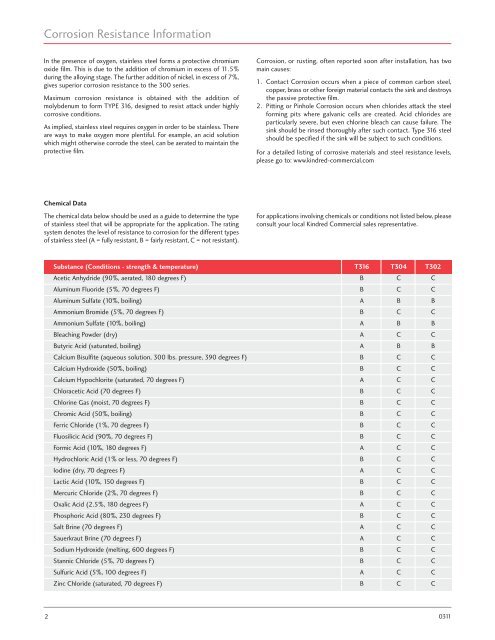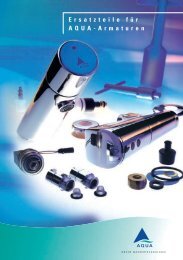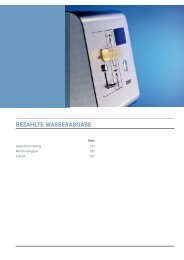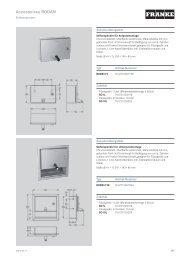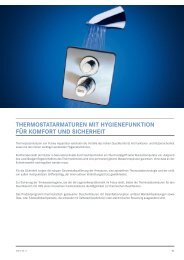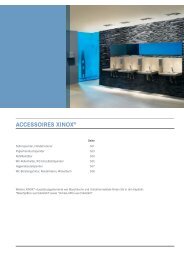Untitled - Franke
Untitled - Franke
Untitled - Franke
Create successful ePaper yourself
Turn your PDF publications into a flip-book with our unique Google optimized e-Paper software.
Corrosion Resistance Information<br />
In the presence of oxygen, stainless steel forms a protective chromium<br />
oxide film. This is due to the addition of chromium in excess of 11.5%<br />
during the alloying stage. The further addition of nickel, in excess of 7%,<br />
gives superior corrosion resistance to the 300 series.<br />
Maximum corrosion resistance is obtained with the addition of<br />
molybdenum to form TYPE 316, designed to resist attack under highly<br />
corrosive conditions.<br />
As implied, stainless steel requires oxygen in order to be stainless. There<br />
are ways to make oxygen more plentiful. For example, an acid solution<br />
which might otherwise corrode the steel, can be aerated to maintain the<br />
protective film.<br />
Chemical Data<br />
The chemical data below should be used as a guide to determine the type<br />
of stainless steel that will be appropriate for the application. The rating<br />
system denotes the level of resistance to corrosion for the different types<br />
of stainless steel (A = fully resistant, B = fairly resistant, C = not resistant).<br />
Corrosion, or rusting, often reported soon after installation, has two<br />
main causes:<br />
1. Contact Corrosion occurs when a piece of common carbon steel,<br />
copper, brass or other foreign material contacts the sink and destroys<br />
the passive protective film.<br />
2. Pitting or Pinhole Corrosion occurs when chlorides attack the steel<br />
forming pits where galvanic cells are created. Acid chlorides are<br />
particularly severe, but even chlorine bleach can cause failure. The<br />
sink should be rinsed thoroughly after such contact. Type 316 steel<br />
should be specified if the sink will be subject to such conditions.<br />
For a detailed listing of corrosive materials and steel resistance levels,<br />
please go to: www.kindred-commercial.com<br />
For applications involving chemicals or conditions not listed below, please<br />
consult your local Kindred Commercial sales representative.<br />
Substance (Conditions - strength & temperature) T316 T304 T302<br />
Acetic Anhydride (90%, aerated, 180 degrees F) B C C<br />
Aluminum Fluoride (5%, 70 degrees F) B C C<br />
Aluminum Sulfate (10%, boiling) A B B<br />
Ammonium Bromide (5%, 70 degrees F) B C C<br />
Ammonium Sulfate (10%, boiling) A B B<br />
Bleaching Powder (dry) A C C<br />
Butyric Acid (saturated, boiling) A B B<br />
Calcium Bisulfite (aqueous solution, 300 lbs. pressure, 390 degrees F) B C C<br />
Calcium Hydroxide (50%, boiling) B C C<br />
Calcium Hypochlorite (saturated, 70 degrees F) A C C<br />
Chloracetic Acid (70 degrees F) B C C<br />
Chlorine Gas (moist, 70 degrees F) B C C<br />
Chromic Acid (50%, boiling) B C C<br />
Ferric Chloride (1%, 70 degrees F) B C C<br />
Fluosilicic Acid (90%, 70 degrees F) B C C<br />
Formic Acid (10%, 180 degrees F) A C C<br />
Hydrochloric Acid (1% or less, 70 degrees F) B C C<br />
Iodine (dry, 70 degrees F) A C C<br />
Lactic Acid (10%, 150 degrees F) B C C<br />
Mercuric Chloride (2%, 70 degrees F) B C C<br />
Oxalic Acid (2.5%, 180 degrees F) A C C<br />
Phosphoric Acid (80%, 230 degrees F) B C C<br />
Salt Brine (70 degrees F) A C C<br />
Sauerkraut Brine (70 degrees F) A C C<br />
Sodium Hydroxide (melting, 600 degrees F) B C C<br />
Stannic Chloride (5%, 70 degrees F) B C C<br />
Sulfuric Acid (5%, 100 degrees F) A C C<br />
Zinc Chloride (saturated, 70 degrees F) B C C<br />
2 0311


